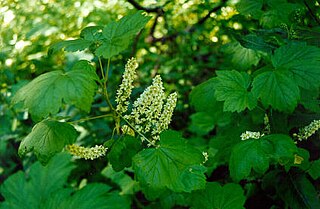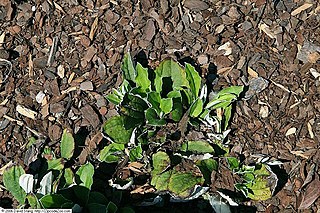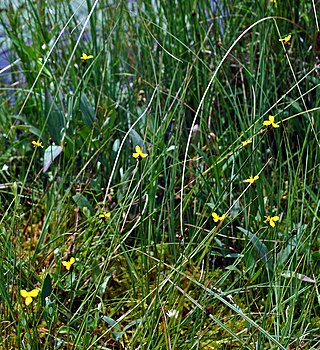
Eriophorum is a genus of flowering plants in the family Cyperaceae, the sedge family. They are found in the cool temperate, alpine, and Arctic regions of the Northern Hemisphere, primarily in the middle latitudes of North America, Europe, and Asia.

Cardamine concatenata, the cutleaved toothwort, crow's toes, pepper root or purple-flowered toothwort, is a flowering plant in the family Brassicaceae. It is a perennial woodland wildflower native to eastern North America.

Helianthus pauciflorus, called the stiff sunflower, is a North American plant species in the family Asteraceae. It is widespread across the Great Plains, the Rocky Mountains, and the Great Lakes region, and naturalized in scattered locations in the eastern United States and in much of southern Canada.

Liatris pycnostachya, the prairie blazing star, cattail gayfeather, Kansas gayfeather, or cattail blazing star, is a perennial plant in the Asteraceae family that is native to the tallgrass prairies of the central United States.

Spinulum annotinum, synonym Lycopodium annotinum, known as interrupted club-moss, or stiff clubmoss, is a species of clubmoss native to forests of the colder parts of North America, as well as Asia, and most of Europe. It is an evergreen perennial pteridophyte. The genus Spinulum is accepted in the Pteridophyte Phylogeny Group classification of 2016, but not in other classifications, which submerge the genus in Lycopodium.

Malaxis monophyllos, the white adder's mouth, is a terrestrial species of orchid. It is widespread across much of Europe, Asia, and much of southern Canada. In the United States, it grows mostly in southern Alaska, New England and the Great Lakes region, with isolated populations reported from Colorado and California.

Allium stellatum, commonly known as the autumn onion, prairie onion, cliff onion, or glade onion, is a North American species of wild onion in the Amaryllidaceae family that is native to central Canada and the central United States.

Rhamnus alnifolia is a species of flowering plant in the buckthorn family known by the common names alderleaf buckthorn, or alder buckthorn. Unlike other "buckthorns", this alder buckthorn does not have thorns. It is native to North America, where it is known mainly from the southern half of Canada and the northern half of the United States and California. It can be found in forested habitat.

Ribes hudsonianum is a North American species of currant, known by the common name northern black currant.

Erigeron pulchellus, the Robin's plantain, blue spring daisy or hairy fleabane, is a North American species of plants in the family Asteraceae. It is widespread across much of the United States and Canada from Québec and Ontario south as far as eastern Texas and the Florida Panhandle.

Eriophorum viridicarinatum is a species of sedge known by the common names thinleaf cottonsedge, green-keeled cottongrass, and bog cottongrass. It is native to Canada and the United States.

Vaccinium oxycoccos is a species of flowering plant in the heath family. It is known as small cranberry, marshberry, bog cranberry, swamp cranberry, or, particularly in Britain, just cranberry. It is widespread throughout the cool temperate northern hemisphere, including northern Europe, northern Asia and northern North America.

Balsamorhiza hookeri is a North American species of perennial plant in the family Asteraceae. It grows in the Great Basin and neighboring regions in the Western United States. It is found in Washington, Oregon, California, Idaho, Nevada, Utah, and Arizona.

Antennaria neglecta is a North American species of flowering plants in the family Asteraceae known by the common name field pussytoes. It is widespread across much of Canada as well as the northeastern and north-central United States.

Antennaria parlinii is a North American species of flowering plants in the family Asteraceae known by the common name Parlin's pussytoes. It is widespread across eastern and central Canada and eastern and central United States, from Manitoba to Nova Scotia south as far as Texas and Georgia.

Solidago uliginosa, or bog goldenrod, is a North American species of flowering plants in the family Asteraceae. It is found in eastern Canada and the eastern United States.

Rubus setosus, the bristly blackberry, is a North American species of flowering plant in the rose family. It is widespread in much of central and eastern Canada and the northeastern and north-central United States

Xyris montana, the northern yelloweyed grass, is a North American species of flowering plants in the yellow-eyed-grass family. It grows in eastern and central Canada and in the northeastern and north-central United States.

Cardamine maxima is a species of flowering plant in the mustard family Brassicaceae.

Eriophorum virginicum, the tawny cottongrass, is a species of flowering plant in the sedge family Cyperaceae. It is native to eastern North America but was introduced into British Columbia in western Canada. It is most common in eastern Canada, New England, and the Great Lakes region. It is the only species of Eriophorum in North America that occurs in the southeastern United States, where it is uncommon. The common name refers to the tawny color of its fruiting head. Despite the name, it is a sedge, not a grass, and it is sometimes called tawny cottonsedge to emphasize this fact.




















